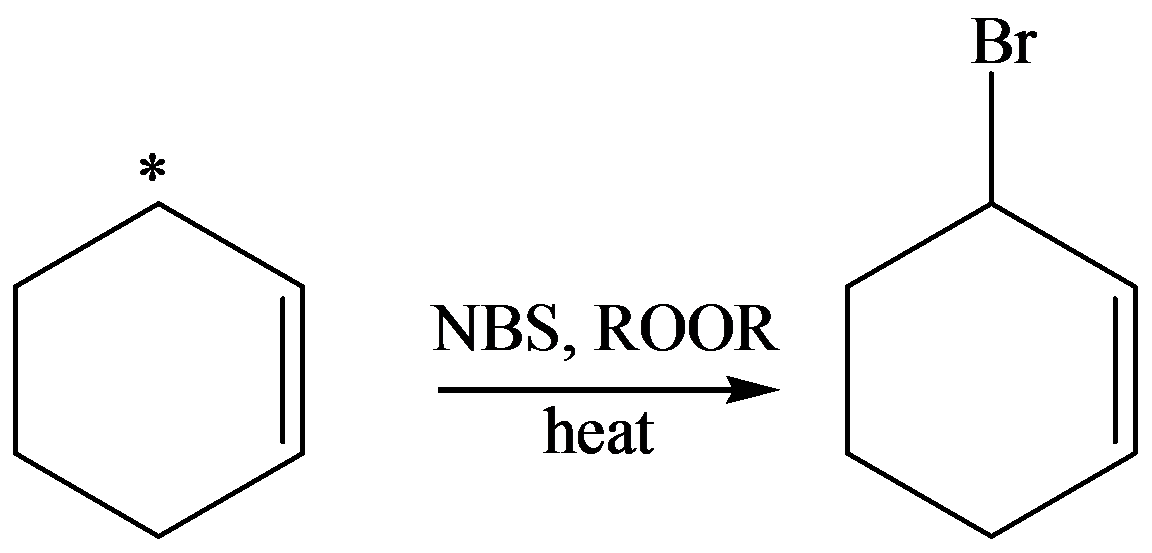
Interpretation: The product formed after reaction of cyclohexane in the presence of
Concept introduction:
Molecules that have one unpaired electron are called free radicals.
Answer to Problem 1PP
Solution:

Explanation of Solution
Given information:

The reaction in the presence of
Allylic bromination is a free radical substitution reaction in which removal of hydrogen atom on carbon adjacent to a double bond with bromine.
Free radical substitution reaction takes place in the presence of
The structure of 3-bromocyclohexence is as follows:

The product formed after free radical substitution is 3-bromocyclohexence.
Want to see more full solutions like this?
Chapter 13 Solutions
Organic Chemistry
- Provide a reasonable arrow-pushing mechanism for Reaction 5b, and explain the the stereochemical outcome. 5d belowarrow_forwardNaOCH3 (S)-1-chloro-1,2-diphenylethane مين من cis-1,2-diphenylethene trans-1,2-diphenylethene + NaCl + HOCH 3 (a) Disregarding stereochemistry for the moment, provide a curved arrow mechanism for the transformation of the starting alkyl halide to one of the products.arrow_forwardolo (S)-1-chloro-1,2-diphenylethane NaOCH3 + NaCl + HOCH3 cis-1,2-diphenylethene trans-1,2-diphenylethene (a) Disregarding stereochemistry for the moment, provide a curved arrow mechanism for the transformation of the starting alkyl halide to one of the products.arrow_forward
- Q12. (1-bromoethyl)benzene 1 udergoes an elimination following an E1 mechanism. Fill in the following synthetic scheme by drawing the structure of intermediate 2 and product 3. The chemical formula of product 3 is provided as guidance. CH; RDS Br C3Hg E1 2 3arrow_forwardComplete the following reaction scheme. Give all product(s) and indicate major or minor and any relevant stereochemistry (g) 1) BH3. THF 2) H202, OH (h) 1) Hg(OАC), H,о 2) NABH4arrow_forward5. Ignoring double-bond stereochemistry, what products would you expect from elimination reactions of the following alkyl halides? Which product will be the major product in each case? çI CHa CH3CHCH2-C-CHCH3 Br ÇH3 CH3CH2CHCHCH3 (a) (b) ÇH3 (c) Br -CHCH3 ČH3arrow_forward
- Provide the major products (write “no reaction” if you think so) for the following reactions with correct stereochemistry.arrow_forwardHow many alkenes yield 2,2,3,4,4−pentamethylpentane on catalytic hydrogenation?arrow_forwardCompounds X and Y are both C7H15Cl products formed in the radical chlorination of 2,4-dimethylpentane. Base-promoted E2 elimination of X and Y gives, in each case, a single C7H₁4 alkene. Both X and Y undergo an SN2 reaction with sodium iodide in acetone solution to give C7H15l products; in this reaction Y reacts faster than X. What is the structure of X? • Do not use stereobonds in your answer. • In cases where there is more than one possible structure for each molecule, just give one for each. . Draw one structure per sketcher. Add additional sketchers using the drop-down menu in the bottom right corner. Separate structures with + signs from the drop-down menu. наarrow_forward
- 1. Bicyclic keto compounds such as camphor react predictably with nucleophiles according to steric influences; this effect has been termed steric approach control. In contrast, the reaction of nucleophiles with simple acyclic and monocyclic keto compounds are influenced primarily by thermodynamic factors; this effect has been termed product development control. Given the following reaction, predict the identity of the major product and provide a rationale for your selection. ОН NABH4 t-Bu. t-Bu t-Bu. ELOH 1 2arrow_forwardShow how the following ethers might be synthesized using (1) alkoxymercuration–demercuration and (2) the Williamson synthesis. (When one of these methods cannot beused for the given ether, point out why it will not work.)(a) 2-methoxybutanearrow_forwardhe following alkene undergoes hydroboration-oxidation to yield a single product rather than a mixture. Explain the result, and draw the product show- ing its stereochemistry. 8.25 From what alkene was the following 1,2-diol made, and what method was used, epoxide hydrolysis or OsO4? 8.26 Predict the products of the following reactions (the aromatic ring is unreactive in all cases). Indicate regiochemistry when relevant. H₂/Pd H or (a) (b) (c) (d) (e) (f) Br₂ Os04 NMO Cl₂, H₂O CH₂I₂, Zn/Cu meta-Chloroperoxy- benzoic acid ? ? ? ? ? ?arrow_forward
 Organic ChemistryChemistryISBN:9781305580350Author:William H. Brown, Brent L. Iverson, Eric Anslyn, Christopher S. FootePublisher:Cengage Learning
Organic ChemistryChemistryISBN:9781305580350Author:William H. Brown, Brent L. Iverson, Eric Anslyn, Christopher S. FootePublisher:Cengage Learning

